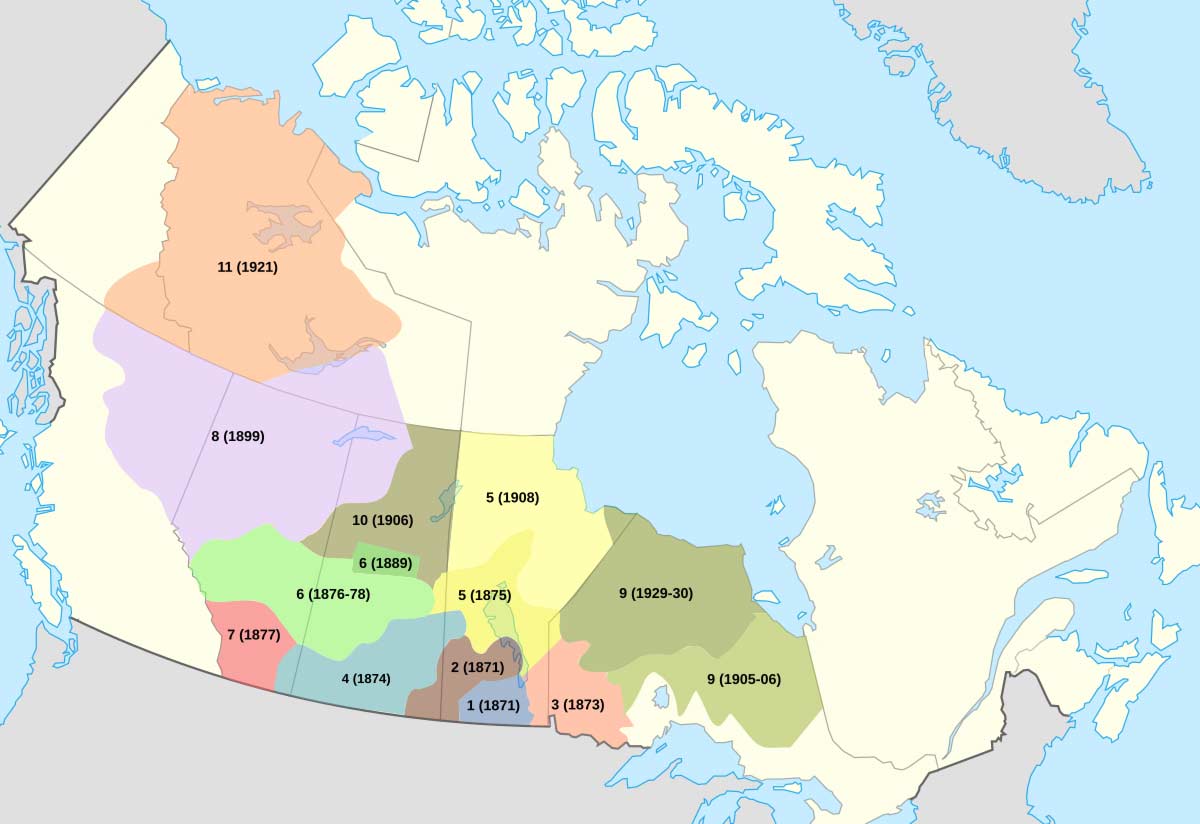
1. Historic Numbered Treaties (1871–1921)
The 11 Numbered Treaties were agreements between the Crown (Canada) and First Nations, mainly covering land surrenders in exchange for reserves, annuities, and rights. Most were negotiated in English, with Indigenous leaders speaking their own languages (Cree, Ojibwe, Dene, etc.).
| Treaty | Year | Region | Key Nations | Language Used | Key Provisions |
|---|---|---|---|---|---|
| Treaty 1 | 1871 | Southern Manitoba | Anishinaabe, Swampy Cree | English, Ojibwe, Cree | 160 acres per family, farming tools, schools. |
| Treaty 2 | 1871 | Manitoba | Anishinaabe | English, Ojibwe | Similar to Treaty 1, but larger land area. |
| Treaty 3 | 1873 | NW Ontario & Manitoba | Ojibwe | English, Ojibwe | Fishing/hunting rights, $5 annuities. |
| Treaty 4 | 1874 | Southern SK & MB | Cree, Saulteaux, Assiniboine | English, Cree, Nakoda | Reserves, farming assistance. |
| Treaty 5 | 1875 | Northern MB & SK | Cree, Saulteaux | English, Cree | Expanded later (1908–1910) for more land. |
| Treaty 6 | 1876 | Central AB & SK | Plains Cree, Woods Cree, Assiniboine | English, Cree | “Medicine Chest Clause” (healthcare promise). |
| Treaty 7 | 1877 | Southern AB | Blackfoot, Stoney Nakoda, Tsuut’ina | English, Blackfoot, Nakoda | Focus on ranching (not farming like others). |
| Treaty 8 | 1899 | Northern AB, BC, SK, NWT | Cree, Dene, Dane-zaa | English, Cree, Dene | Guaranteed hunting/fishing rights. |
| Treaty 9 | 1905–06 | Northern ON | Ojibwe, Cree | English, Ojibwe, Cree | Promised economic support (rarely fulfilled). |
| Treaty 10 | 1906 | Northern SK | Cree, Dene | English, Cree | Last “numbered” treaty in the Prairies. |
| Treaty 11 | 1921 | NWT | Dene, Gwich’in | English, Dene | Signed during oil/gold rush; many promises broken. |
Key Issues:
- Many treaties were misinterpreted (oral vs. written terms).
- Broken promises (e.g., starvation due to banned hunting, underfunded schools).
- Ongoing disputes over land use (e.g., pipelines on unceded territory).
2. Peace & Friendship Treaties (1725–1779)
Eastern Canada (Maritimes, Quebec) – Focused on coexistence, not land surrender.
| Treaty | Year | Region | Key Nations | Language |
|---|---|---|---|---|
| Boston Treaty | 1725 | Mi’kmaq, Wolastoqey | English, Mi’kmaq | |
| Halifax Treaties | 1760–61 | Mi’kmaq | English, Mi’kmaq | |
| Treaty of Niagara | 1764 | Haudenosaunee, Anishinaabe | English, Anishinaabemowin |
Significance: Still cited in court cases today (e.g., fishing rights in R v. Marshall).
3. Upper Canada Treaties (1764–1862)
Pre-Confederation land agreements in Ontario.
| Treaty | Year | Nations | Key Details |
|---|---|---|---|
| Treaty of Niagara | 1764 | Haudenosaunee, Anishinaabe | Belt Covenant (Wampum) reaffirmed. |
| Huron Tract Treaty | 1827 | Anishinaabe | Controversial land surrender. |
4. Vancouver Island (Douglas) Treaties (1850–1854)
14 treaties signed by Gov. James Douglas with Coast Salish nations.
- Language: English, but oral agreements in SENĆOŦEN, Hul’q’umi’num’.
- Issue: Poorly explained; many nations didn’t realize they were surrendering land.
5. Modern Treaties (1975–Present)
Land claims agreements since 1973 (after Calder v. BC recognized Indigenous land rights).
| Treaty | Year | Region | Nations | Key Points |
|---|---|---|---|---|
| James Bay & Northern Quebec Agreement | 1975 | Quebec | Cree, Inuit | First modern treaty; halted Hydro-Québec dams. |
| Nunavut Land Claims Agreement | 1993 | Nunavut | Inuit | Led to Nunavut’s creation (1999). |
| Nisga’a Treaty | 2000 | BC | Nisga’a | First BC treaty in 100+ years; self-government. |
Total modern treaties: ~25, including:
- Tłı̨chǫ Agreement (NWT)
- Tsawwassen Treaty (BC)
- Inuvialuit Final Agreement (NWT/Yukon)
6. Unceded Land & Disputed Treaties
Many nations never signed treaties, including:
- Most of British Columbia (except Douglas Treaties/Nisga’a).
- Algonquin Territory (ON/QC) – Ongoing negotiations.
Key Takeaways
- Treaties were nation-to-nation agreements – but Canada often broke promises.
- Language barriers led to misunderstandings (oral vs. written terms).
- Modern treaties include self-government, resource-sharing.
- Unceded land remains a major issue (e.g., Wet’suwet’en protests).
Further Learning:
- 📜 Treaty Texts (Gov’t of Canada)
- 📖 Treaty Words by Aimée Craft (Anishinaabe lawyer)
- 🎥 Trick or Treaty? (2014 doc on Treaty 9)
